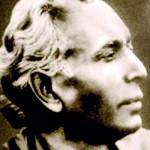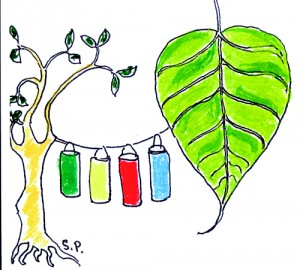Sunday Times 2
Lanterns in the garden
Viewed from the high perch of adulthood, the Vesak we knew as children was a long garland of lanterns, strung up in a large garden at the end of a private lane. The garden belonged to a large house on the corner, down a bylane off Queen’s Road, Colombo 3. The garden was enclosed by a short wall and a thick hedge of bougainvillea.
For us, 12 years and Christian, the garden represented holy places in North India. Lumbini, Kapilavastu, Kushinagar, Nalanda, Varanasi — mysterious names that gave off the scent of incense. We had found these names in the school history book, in the chapter on the birth of Buddhism, 2,500 years ago. The chapter evoked misted mountains, icy rivers, and forests alive with the dancing of deer.

Anagarika Dharmapala
These faraway places were exotically strange, and doubly distant because they belonged to a world we were not a part of. Our world was that of Christmas trees and chocolate Easter eggs. The world of the garden at the end of the lane and the house that stood there was that of the Buddha and the Sacred Bo Tree. The day and night of the lanterns marked the day the Buddha was born, died and attained Enlightenment.
We were invited into the garden to look at the lanterns that had been put up that morning. We gazed long at the glowing eyes of red and blue, green and yellow. It was a still night, with no breeze to sway the lanterns. A full moon blazed directly overhead.
The lanterns hung in festoons, linking frangipani trees. In sunlight, the yellow, red, green and blue oil paper lanterns were solid cylinders of colour, satisfying to look at. They were hollow but looked full. At night, as the fireflies arrived, the cylinders filled with fire and air and colour. They glowed noiselessly in the tree shadows, above the ticking of the night insects. The moon had turned the grass blue. By day, the lawn was a field for little cricketers, maximum age 12. We had played a game on the lawn that morning, on grass brittle gold with sunlight.
The distance between the side gate of our home and garden, diametrically opposite, at the other corner of the private lane, and the side entrance of the other home and garden was roughly 22 yards, the length of a cricket pitch. There were six players and two teams of three each. At the end of a match, the players crossed over and formed new teams. The players were Ananda and Prasanna, and their  visiting cousins Janek and Sinha. The two guest players were Younger Brother and Self. The games went on till it was time to head home for lunch.
visiting cousins Janek and Sinha. The two guest players were Younger Brother and Self. The games went on till it was time to head home for lunch.
In our home, Christmas was a time of high cheer and merriment, and flashes of scarlet and gold and silver. The trees in our garden joined in the merriment and their leaves glittered, like cousins of the tinselly evergreen Christmas tree inside the house. Carol singing on the radio could be heard from the top of the trees in our garden. It was a day of celebration and festivity, marking a Birth special to a Christian family.
Vesak was the special time of year for the other home, where coconut oil lamps lined the driveway. The atmosphere of that day and night of lanterns was not one of merriment and song and firecrackers. There, it was solemn and very, very quiet. The only sounds were the ticking of the night insects and a papery whisper when a breeze stirred the streamers of the large white lotus lantern hanging under the porch.
We started to understand, in a glimmering way, the difference between Christmas and Vesak. One celebrated a Birth, the other marked a Birth, a Death, and a Supreme State of Being. One was a day and night of song and cheer, the other a time of repose, introspection, stasis and silence.
Vesak, to that Christian boy of 12, was a neighbourhood garden that suggested Lumbini and Kushinagara, and the scent of plumeria and the smell of slow-burning coconut oil and slow-melting candle wax, and the mysterious lights of lanterns.
The little cricketers met daily during the school holidays.
There was a large Bo Tree (peepal, ficus religiosa) growing at the south-east corner of Hatton Court, on Queen’s Road. Its branches stretched over the wall and its leaves drifted onto Queen’s Avenue and the garden where we played cricket.
One morning, Prasanna called out as we ran across the lawn where the grass was thin and the sand showed through. We had stepped on a fallen Bo leaf. He explained that the leaf was sacred to Buddhists, as the Buddha attained Enlightenment under a Bo Tree. We apologised. Since that hot bright day, in 1960, we never fail, when out walking, to make sure we do not tread on a fallen Bo leaf.
One day, after an especially hot morning of matches, we filed into the large house for a drink of iced water. High on the wall over the wooden staircase was a large photograph. It was a profile, a portrait; a noble face, a dignified head with wavy long hair, an impressive receding brow, kindly, far-seeing eyes, sensitive lips, strong chin.
We looked long at the portrait. We asked who it was.
Prasanna, one of the little cricketers, said it was that of a distant relative. We drank our iced water and left.
It would be only much later that we would learn that the portrait in the house at the corner was that of the great Buddhist revivalist and leader, Anagarika Dharmapala, whose original name was Don David Hewavitarne. The house was the home of Gamani and Sita Jayasuriya, married cousins who were a grand-nephew and a grand-niece of Anagarika Dharmapala.
Forty-five years after our last friendly cricket encounter in the garden that evoked sacred places in North India, we bumped into Prasanna Jayasuriya. We told him that the adult Prasanna looked a lot like his father, the late Gamani Jayasuriya, Member of Parliament, nationalist and Buddhist activist. After reading up on Anagarika Dharmapala and studying photographs of the Buddhist leader, we called Prasanna Jayasuriya, who is a trustee of the Anagarika Dharmapala Trust and president of the Maha Bodhi Society of India, to tell him how much he looks like his distinguished great-grand-uncle.
We discussed the possibility of joining him on one of his regular visits to India, to go to the sacred sites of North India, the gardens of Lumbini, Kapilavastu, Kushinagar, Nalanda and Varanasi.
The other day, walking along the pavement in a noisy part of Rajagiriya, we stopped in front of the Church of the Sacred Heart. There is a large Bo tree here, above the bus stand. The ground was covered with fallen leaves and we were treading cautiously. A dry skeleton leaf caught our eye. The green was all gone, and only the fine brown filaments of the leaf structure remained. We picked up the leaf, and as we turned it in our hand, the leaf filigree caught the sun and turned from brown to bronze, and from silver to gold.

